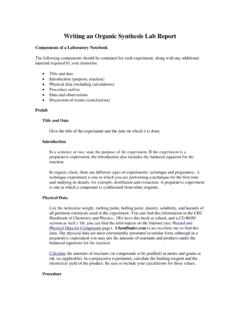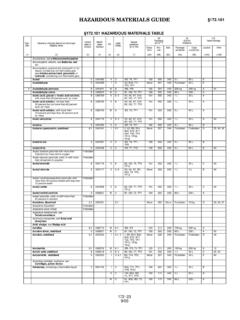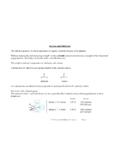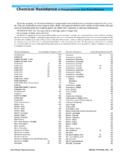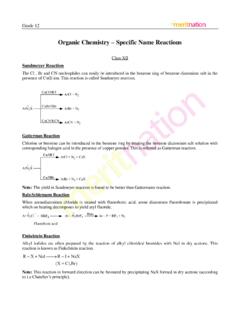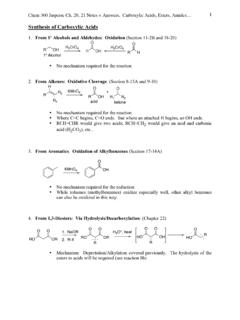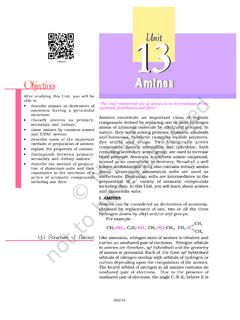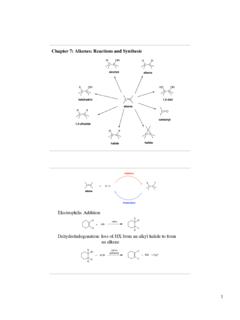Transcription of Mass Spectrometry: Fragmentation - MiamiOH.edu
1 mass spectrometry : Fragmentation Ethers & Sulfides!!!!! Ethers M+ usually stronger than corresponding alcohol; may be weak/absent -cleavage of an alkyl radical Inductive cleavage Rearrangement with loss of CHR=CHR Aryl Ethers M+ strong C-O cleavage to aromatic ring with subsequent loss of CO Cleavage adjacent to aryl ring also possible Sulfides M+ usually stronger than corresponding ether cleavage pattern similar to ethers mass spectrometry : Fragmentation Ethers Fragmentation patterns -cleavage inductive cleavage rearrangement RCH2OR'OHHR'R +RCH2OR'+RCH2OR'OCH2 HHCHRH+ H2C=CHROHHHMass spectrometry : Fragmentation Ethers ethyl propyl ether M (88) 73 M-15 59 M-29 OMW = 88 OHHOHHCH3CH2m/z = 29 CH2CH2CH3m/z = 43 OHHHm/z = 31 mass spectrometry : Fragmentation Ethers di-sec-butyl ether OMW = 130M (130) 115 M-15 101 M-29 OHCH3CH2 OHH3Cm/z = 59 m/z = 45 OHHH3 COHHCH3CH2m/z = 57 mass spectrometry .
2 Fragmentation Ethers 2-ethyl-2-methyl-1,3-dioxolane OOMW = 116101 M-15 87 M-29 M+ absentOOOOMass spectrometry : Fragmentation Aryl Ethers anisole 93 M-15 m/z = 78 MW = 108 OCH3m/z = 65 Oloss ofCOM (108) HHMass spectrometry : Fragmentation Aryl Ethers Fragmentation of aryl ethers OCH2Hm/z = 78m/z = 77 OCH2 HHH- CH2O- H OCH3m/z = 93m/z = 65- CH3O- COMass spectrometry : Fragmentation Sulfides ethyl isopropyl sulfide SMW = 104M (104) mz = 61 89 M-15 75 M-29 mass spectrometry : Fragmentation Amines!!!!! Aliphatic Amines M+ will be an odd number for monoamine; may be weak/absent M-1 common -cleavage of an alkyl radical is predominate Fragmentation mode largest group lost preferentially McLafferty rearrangement / loss of NH3 (M-17) are not common Cyclic Amines M+ usually strong M-1 common Fragmentation complex, varies with ring size Aromatic Amines M+ usually strong M-1 common loss of HCN is common in anilines mass spectrometry : Fragmentation Amines Fragmentation patterns -cleavage ring formation NH2 RNH2R +nnRNR+NR"HHR'R"R'n = 1, m/z = 72 n = 2, m/z = 86 loss of H radical RNRNR'R"HR'R"+ HM-1 mass spectrometry : Fragmentation Amines ethylamine NH2MW = 45M (45) mz = 30 44 M-1 NHHHH base peakNHHHMass spectrometry : Fragmentation Amines diethylamine NHMW = 73M (73) 72 M-1 58 M-15 m/z = 30 NHHHH cleavageNHMass spectrometry .
3 Fragmentation Amines triethylamine NMW = 101m/z = 30 NHHHHM (101) 100 M-1 86 M-15 cleavageMass spectrometry : Fragmentation Amines N-ethylpropylamine NHMW = 87M (87) m/z = 30 72 M-15 58 M-29 cleavageMass spectrometry : Fragmentation Cyclic Amines piperidine M (85) 84 M-1 MW = 85NH84 M-28 NHand NHMass spectrometry : Fragmentation Aromatic Amines aniline M (93) 92 M-1 NH2MW = 93 NHHH-HCNM-1m/z = 66m/z = 65- Hm/z = 65 mass spectrometry : Fragmentation Carbonyl Compounds!!!! -cleavage (two possibilities) -cleavage McLafferty rearrangement Common Fragmentation Modes RGOCOR+ GRGOCOGR +GORR +GOG = H, R', OH, OR', NR'2 GORHGOHR+ mass spectrometry : Fragmentation Carbonyl Compounds!!!! Aldehydes M+ usually observed; may be weak in aliphatic aldehydes M-1 common ( -cleavage) -cleavage is predominant Fragmentation mode; often diagnostic (m/z = 29) especially in aromatic aldehydes (M-1; M-29) -cleavage results in M-41 fragment.
4 Greater if -substitution McLafferty rearrangement in appropriately substituted systems (m/z = 44 or higher) Ketones M+ generally strong -cleavage is the primary mode of Fragmentation -cleavage less common, but sometimes observed McLafferty rearrangement possible on both sides of carbonyl if chains sufficiently long Cyclic ketones show complex Fragmentation patterns Aromatic ketones primarily lose R upon -cleavage, followed by loss of CO mass spectrometry : Fragmentation Aliphatic Aldehydes pentanal HOMW = 86M (86) mz = 29 85 M-1 mz = 43 mz = 44 McLafferty cleavageHOHCH3CH2CH2 COH cleavageCOC4H9 cleavageMass spectrometry : Fragmentation Aldehydes 2-ethylbutanal M (100) mz = 29 m/z = 72 COHHOMW = 100 HOHMass spectrometry : Fragmentation Aromatic Aldehydes benzaldehyde M (106) 105 M-1 mz = 77 HOMW = 106 mass spectrometry : Fragmentation Aliphatic Ketones 2-hexanone OMW = 100M (100) mz = 58 85 M-15 43 M-57 COOHCH3 COMcLafferty cleavage cleavageMass spectrometry : Fragmentation Ketones acetophenone M (120) mz = 77 105 M-15 OMW = 120 COMass spectrometry : Fragmentation Cyclic Ketones cyclohexanone OMW = 98M (98) mz = 55 mz = 70 mz = 42 OOMass spectrometry : Fragmentation Cyclic Ketones cyclohexanone OOHOHO+HOHm/z = 55O+m/z = 42- COm/z = 70 mass spectrometry : Fragmentation Carboxylic Acids, Esters & Amides!
5 !! Carboxylic Acids M+ weak in aliphatic acids; stronger in aromatic acids Most important -cleavage involves loss of OH radical (M-17) -cleavage with loss of alkyl radical less common; somewhat diagnostic (m/z = 45) McLafferty rearrangement in appropriately substituted systems (m/z = 60 or higher) Dehydration can occur in o-alkyl benzoic acids (M-18) Esters M+ weak in most cases; aromatic esters give a stronger parent ion Loss of alkoxy radical more important of the -cleavage reactions Loss of an alkyl radical by -cleavage occurs mostly in methyl esters (m/z = 59) McLafferty rearrangements are possible on both alkyl and alkoxy sides Benzyloxy esters and o-alkyl benzoates fragment to lose ketene and alcohol, respectively Amides M+ usually observed; Follow the Nitrogen Rule (odd # of N, odd MW) -cleavage affords a specific ion for primary amides (m/z = 44?)
6 McLafferty rearrangement observed when -hydrogens are present mass spectrometry : Fragmentation Aliphpatic Carboxylic Acids butyric acid OHOMW = 88M (88) mz = 45 71 M-17 weak M+mz = 60 COOOHHOHCOMass spectrometry : Fragmentation Carboxylic Acids 2,4-dimethylbenzoic acid OOHCH3H3 CMW = 150M (150) mz = 77 132 M-18 133 M-17 strong M+OOHCOH- H2 OMass spectrometry : Fragmentation Esters methyl butyrate OCH3 OMW = 102M (102) 71 M-31 59 M-43 74 M-28 15 M-87 OCH3 OHMcLaffertyCH3 cleavageCH3CH2CH243 M-59 OOCH3loss of:inductivecleavage87 M-15 mass spectrometry : Fragmentation Esters butyl butyrate M (144) absent 101 M-43 89 OOMW = 144 McLafferty + 1 PrOOHH71 M-73 McLaffertyPrOOH88 mass spectrometry : Fragmentation Esters Fragmentation patterns McLafferty rearrangement McLafferty + 1 PrOOHPrOOHPrOOHHPrOOHH+m/z = 89 OOHPrOOH+m/z = 88 OOHOOH+BuBum/z = 116(not observed) mass spectrometry : Fragmentation Esters benzyl acetate M (150) 108 M-42 91 M-59 OOMW = 150OH43 M-108 cleavagetropylium ion OMass spectrometry : Fragmentation Esters Fragmentation patterns Loss of alcohol Benzyl ester rearrangement OHOOH+OCCH2can fragment furtherOORCOXHX+HORX = CH2, OMass spectrometry : Fragmentation Amides butyramide NH2 OMW = 87M (87) 59 M-28 mz = 44 OCNH2NH2 OHMcLafferty cleavageMass spectrometry : Fragmentation Amides N-ethylpropionamide M (101) 72 M-29 57 M-44 NHOMW = 101mz = 29 86 M-15 mz = 30 NCH2 HHCH3CH2 NHOMass spectrometry : Fragmentation Aryl Amides N-methylbenzamimde M (135) 105 M-29 mz = 77 NCH3 HOMW = 135M-1 mass spectrometry .
7 Fragmentation Nitriles Nitriles M+ may be weak/absent; strong M+ in aromatic nitriles; follow nitrogen rule Fragment readily to give M-1 Loss of HC N fequently obsterved (M-27); aromatic nitriles also show loss of CN (M-26) McLafferty rearrangement in nitriles of appropriate length (m/z = 41) mass spectrometry : Fragmentation Nitriles Fragmentation patterns McLafferty rearrangement Loss of -hydrogen RCHH +NCCM-1 RHNLoss of HCN CR +NH2 CCNHHRm/z = 41 RCHR +NHCNM-27 mass spectrometry : Fragmentation Nitriles hexanenitrile M (97) 70 M-27 mz = 41 96 M-1 CNMW = 97 CCC4H9 HNH2 CCNHMcLaffertyMass spectrometry : Fragmentation Nitro Compounds & Halides Nitro Compounds M+ almost never observed unless aromatic; follow nitrogen rule Principle degradation is loss of NO+ (m/z = 30) and loss of NO2+ (m/z = 46) Aromatic nitro compounds show additional Fragmentation patterns Halides M+ often weak.
8 Stronger in aromatic halides chloro and bromo compounds show strong M+2 peaks Cl M : M+2 3 : 1 Br M : M+2 1 : 1 principle Fragmentation is loss of halogen Loss of HX also common -cleavage sometimes observed mass spectrometry : Fragmentation Nitro Compounds Fragmentation patterns RNOOR +NOOm/z = 46 RNOORONORONOm/z = 30+NO2O+ NOCO+m/z = 65m/z = 93NO2+ NO2 HHC4H3 +m/z = 77m/z = 51 mass spectrometry : Fragmentation Nitro Compounds 1-nitropropane 43 M-46 MW = 89NO2M (89) absent mz = 30 mz = 46 NONOOCH3CH2CH2 mass spectrometry : Fragmentation Nitro Compounds nitrobenzene M (123) NO2MW = 123mz = 30 NOmz = 65 mz = 51 77 M-NO2 O93 M-NO mass spectrometry : Fragmentation Organic Halides Fragmentation patterns Loss of Halide Loss of Chain -cleavage Loss of HX RCXHHCXHHR +CCXRHHHHCCH2RH+ HXHF > HCl > HBr > HIXRXR +RXR + XI > Br >> Cl > FMass spectrometry : Fragmentation Alkyl Halides 1-chloropropane M (78) mz = 49, 51 80 M+2 ClMW = 7842 M-HCl 43 M-Cl CH3CH2CH2 CClHH cleavageMass spectrometry : Fragmentation Alkyl Halides 2-chloropropane m/z = 63, 65 43 M-Cl ClMW = 78M (78) 80 M+2 CClHCH3 mass spectrometry : Fragmentation Alkyl Halides 2-chloroheptane M (134) M+2 (136) m/z = 105, 107 56 M-78 ClMW = 13498 M - HCl ClHClHClrearrngementMass spectrometry : Fragmentation Alkyl Halides 2-bromopropane BrMW = 12343 M-Br M (122) 124 M+2 CH3 CHCH3 mass spectrometry .
9 Fragmentation Alkyl Halides 1-bromohexane 85 M-Br BrMW = 165M (164) 166 M+2 mz = 135, 137 mz = 57 rearrngementBrMass spectrometry : Fragmentation Alkyl Halides bromobenzene M (156) 158 M+2 mz = 77 BrMW = 157 mass spectrometry : Fragmentation What Can the MS Tell You?! Evaluation of UnknownCompounds by mass Spectr 1. Get an overview of the spectrum. Is it simple? Complex? Are there groups of peaks? 2. Identify and evaluate the molecular ion. - Is M+ strong or weak? - Are their significant peaks due to isotopes ( M+1, M+2, etc.)? - Is the molecular ion an odd number (Apply the Nitrogen Rule)? - Is there an M-1 Peak? - If a molecular formular is not provided, check tables or on-line calculators to determine possible formulas 3. Evaluate the major fragments - What mass is lost from M+ to give these peaks?
10 - What ions could give these peaks? - If available, use IR data to identify functionality, and consider known Fragmentation patterns of these groups. - Consider the loss of small neutral molecules ( H2O, HOR, H2C=CH2, HC CH, HX, CO2, etc.) - Consider possible diagnostic peaks ( m/z = 29, 30, 31, 39, 41, 44, 91, 45, 59, etc.) 4. Use Fragmentation information to piece together possible structure mass spectrometry : Fragmentation Commonly Lost Fragments Pavia Appendix 11 mass spectrometry : Fragmentation Common Fragment Peaks Pavia Appendix 12 mass spectrometry : Fragmentation Reporting mass Spec Data Low Resolution mass Spec OCH3 OMW = 102M (102) 71 M-31 59 M-43 74 M-28 15 M-87 43 M-59 Source Temperature: 240 C Sample Temperature: 180 C RESERVOIR, 75 eV 87 M-15 spectrometry Reporting mass Spec Data Low Resolution mass Spec OCH3 OMW = 102MS (EI, 75 eV): m/z 102 (M+, 1%), 87 (16), 74 (64), 71 (50), 59 (22), 43 (100).
